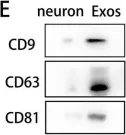Spinal cord injury (SCI) remains a significant health concern, with limited available treatment options. This condition poses significant medical, economic, and social challenges. SCI is typically categorized into primary and secondary injuries. Inflammation, oxidative stress, scar formation, and the immune microenvironment impede axon regeneration and subsequent functional restoration. Numerous studies have shown that the destruction of the blood-brain barrier (BBB) and microvessels is a crucial factor in severe secondary injury. Additionally, reactive oxygen species (ROS)-induced lipid peroxidation significantly contributes to endothelial cell death. Pericytes are essential constituents of the BBB that share the basement membrane with endothelial cells and astrocytes. They play a significant role in the establishment and maintenance of BBB.
Immunofluorescence staining at different time points revealed a consistent correlation between pericyte coverage and angiogenesis, suggesting that pericytes promote vascular repair via paracrine signaling. Pericytes undergo alterations in cellular morphology and the transcriptome when exposed to hypoxic conditions, potentially promoting angiogenesis. We simulated an early ischemia-hypoxic environment following SCI using glucose and oxygen deprivation and BBB models. Co-culturing pericytes with endothelial cells improved barrier function compared to the control group. However, this enhancement was reduced by the exosome inhibitor, GW4869. In vivo injection of exosomes improved BBB integrity and promoted motor function recovery in mice following SCI. Subsequently, we found that pericyte-derived exosomes exhibited significant miR-210-5p expression based on sequencing analysis. Therefore, we performed a series of gain- and loss-of-function experiments in vitro.
Our findings suggest that miR-210-5p regulates endothelial barrier function by inhibiting JAK1/STAT3 signaling. This process is achieved by regulating lipid peroxidation levels and improving mitochondrial function, suggesting a potential mechanism for restoration of the blood-spinal cord barrier (BSCB) after SCI.
© 2023. The Author(s).
Product Citations: 8
In Journal of Nanobiotechnology on 27 November 2023 by Gao, P., Yi, J., et al.
-
WB
-
Cell Biology
-
Neuroscience
Circulating Pro-Inflammatory Exosomes Worsen Stroke Outcomes in Aging.
In Circulation Research on 17 September 2021 by Zhang, H., Lin, S., et al.
Expression and functions of cluster of differentiation 9 and 81 in rat mammary epithelial cells.
In The Journal of Reproduction and Development on 22 December 2020 by Horiguchi, K., Yoshida, S., et al.
Cluster of differentiation (CD) 9 and CD81 are closely-related members of the tetraspanin family that consist of four-transmembrane domain proteins. Cd9 and Cd81 are highly expressed in breast cancer cells; however, their expression in healthy mammary glands is unclear. In this study, we performed quantitative real-time PCR to analyze the expression levels of Cd9 and Cd81. Histological techniques were employed to identify Cd9- and Cd81-expressing cells in rat mammary glands during pregnancy and lactation. It was observed that Cd9 and Cd81 were expressed in the mammary glands, and their expression levels correlated with mammary gland development. To identify cells expressing Cd9 and Cd81 in the mammary glands, we performed double immunohistochemical staining for CD9 and CD81, prolactin receptor long form, estrogen receptor alpha, or Ki67. The results showed that CD9 and CD81 were co-expressed in proliferating mammary epithelial cells. Next, we attempted to isolate CD9-positive epithelial cells from the mammary gland using pluriBead cell-separation technology based on antibody-mediated binding of cells to beads of different sizes, followed by isolation using sieves with different mesh sizes. We successfully isolated CD9-positive epithelial cells with 96.8% purity. In addition, we observed that small-interfering RNAs against Cd9 and Cd81 inhibited estrogen-induced proliferation of CD9-positive mammary epithelial cells. Our current findings may provide novel insights into the proliferation of mammary epithelial cells during pregnancy and lactation as well as in pathological processes associated with breast cancer.
-
Rattus norvegicus (Rat)
CD2 is a surface marker for mouse and rat spermatogonial stem cells.
In The Journal of Reproduction and Development on 20 August 2020 by Kanatsu-Shinohara, M., Chen, G., et al.
The spermatogonial stem cell (SSC) population in testis is small, and the lack of SSC markers has severely handicapped research on these cells. During our attempt to identify genes involved in SSC aging, we found that CD2 is expressed in cultured SSCs. Flow cytometric analysis and spermatogonial transplantation experiments showed that CD2 is expressed in SSCs from mature adult mouse testes. Cultured SSCs transfected with short hairpin RNAs (shRNAs) against CD2 proliferated poorly and showed an increased frequency of apoptosis. Moreover, functional analysis of transfected cells revealed impairment of SSC activity. Fluorescence activated cell sorting and spermatogonial transplantation experiments showed that CD2 is expressed not only in mouse but also in rat SSCs. The results indicate that CD2 is a novel SSC surface marker conserved between mouse and rat SSCs.
-
Stem Cells and Developmental Biology
Purification of dorsal root ganglion neurons from rat by immunopanning.
In Cold Spring Harbor Protocols on 1 August 2014 by Zuchero, J. B.
Dorsal root ganglion neurons (DRGs) are sensory neurons that facilitate somatosensation and have been used to study neurite outgrowth, regeneration, and degeneration and PNS and CNS myelination. Studies of DRGs have relied on cell isolation strategies that generally involve extended culture in the presence of antimitotic agents or other cytotoxic treatments that target dividing cells. The surviving cells typically are dependent on serum for growth. Other methods, involving purification of DRGs based on their large size, produce low yield. In contrast, the immunopanning-based method described here for prospective isolation of DRGs from rodents allows for rapid purification in the absence of antimitotic agents and serum. These DRG cultures take place in a defined medium. They are free of Schwann cells and other glia and thus can be used to study the role of glia in the biology of DRG neurons.
© 2014 Cold Spring Harbor Laboratory Press.
-
Rattus norvegicus (Rat)
-
Neuroscience
-
Plant Science
In J Nanobiotechnology on 27 November 2023 by Gao, P., Yi, J., et al.
Fig.2.E

-
WB
-
Collected and cropped from J Nanobiotechnology by CiteAb, provided under a CC-BY license
Image 1 of 1
